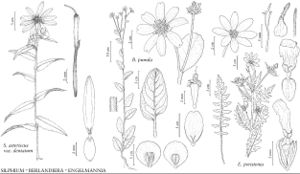Silphium
Sp. Pl. 2: 919. 1753.
Gen. Pl. ed. 5, 391. 1754.
Perennials, 20–250+ cm (fibrous-rooted, rhizomatous, or taprooted). Stems usually erect, usually branched (terete or square, often vernicose with resinous exudates). Leaves basal and cauline (basal persistent or withering before flowering); whorled, opposite, subopposite, or alternate (sometimes all conditions on one plant); petiolate or sessile; blades (1-nerved or 3-nerved) deltate, elliptic, linear, ovate, or rhombic, sometimes 1–2-pinnately lobed or pinnatifid, bases cordate or truncate to cuneate, margins entire or toothed, faces glabrous or hairy (sometimes stipitate-glandular). Heads radiate, in paniculiform or racemiform arrays. Involucres campanulate to hemispheric, 10–30 mm diam. Phyllaries persistent, 11–45 in 2–4 series (outer broader, foliaceous, inner smaller, thinner, each subtending a ray-floret). Receptacles flat to slightly convex, paleate (paleae oblong, lanceolate, or linear). Ray-florets 8–35+ in 1–4 series, pistillate, fertile; corollas yellow or white. Disc-florets 20–200+, functionally staminate; corollas yellow or white, tubes much shorter than narrow, cylindric throats, lobes 5, deltate. Cypselae (black to brown) obflattened (± winged, shed alone without accessory structures); pappi 0, or persistent, of 2 awns (± confluent with cypsela shoulders and wings). x = 7.
Distribution
North America
Discussion
Species 12 (12 in the flora).
In keys and descriptions here, “plants scapiform” indicates plants with distal cauline leaves notably smaller than basal and proximal cauline leaves, and “plants caulescent” indicates plants with leaves ± uniform in size throughout; “leaves persistent” indicates leaves persisting to flowering time, and “leaves caducous” indicates leaves withering before flowering time.
Selected References
Lower Taxa
Key
| 1 | Stems square (distal leaf or petiole bases connate-perfoliate) | Silphium perfoliatum |
| 1 | Stems terete or slightly 4-angled (distal leaves not perfoliate) | > 2 |
| 2 | Leaves (at least proximal) usually laciniate, pinnatifid, or 1–2-pinnately lobed (lobes 3–15) | > 3 |
| 2 | Leaves (proximal and distal) seldom lobed (sometimes with 2 basal lobes, then hastate, sagittate, or auriculate) | > 6 |
| 3 | Ray florets 6–12 | Silphium compositum |
| 3 | Ray florets 14–40 | > 4 |
| 4 | Corollas white | Silphium albiflorum |
| 4 | Corollas yellow | > 5 |
| 5 | Phyllaries appressed, apices acute to obtuse | Silphium terebinthinaceum |
| 5 | Phyllaries reflexed or appressed, apices acuminate to caudate | Silphium laciniatum |
| 6 | Plants taprooted (scapiform; cauline leaves notably smaller distally) | > 7 |
| 6 | Plants fibrous rooted (caulescent; cauline leaves not notably smaller distally) | > 8 |
| 7 | Ray flowers 6–12 | Silphium compositum |
| 7 | Ray flowers 17–29 | Silphium terebinthinaceum |
| 8 | Leaves (at least proximal leaves) petiolate (never sessile), bases truncate, cordate, auriculate, hastate, or sagittate | > 9 |
| 8 | Leaves (proximal and distal) petiolate (blade bases round to tapered) or sessile (blade bases round to cordate) | > 10 |
| 9 | Stems glabrous; basal leaves caducous | Silphium brachiatum |
| 9 | Stems hispid; basal leaves persistent | Silphium wasiotense |
| 10 | Phyllaries: abaxial faces usually glabrous (rarely scabrous in outer series) | > 11 |
| 10 | Phyllaries: abaxial faces glandular, hirsute, hispid, or scabrous | > 12 |
| 11 | Ray florets 20–36+ | Silphium integrifolium |
| 11 | Ray florets 8–17 | Silphium asteriscus |
| 12 | Leaf faces stipitate-glandular | Silphium glutinosum |
| 12 | Leaf faces eglandular | > 13 |
| 13 | Basal leaves persistent | > 14 |
| 13 | Basal leaves caducous | > 15 |
| 14 | Leaf faces shaggy-hispid; phyllaries hispid; corollas pale yellow; cypselae 6–10mm; Alabama, Georgia, Tennessee | Silphium mohrii |
| 14 | Leaf faces hirsute, hispid, or scabrous; phyllaries scabrous; corollas bright yellow; cypselae 10–17 mm; Louisiana, Texas | Silphium radula |
| 15 | Cauline leaves opposite (clasping stems) | Silphium integrifolium |
| 15 | Cauline leaves opposite or alternate (not clasping stems) | > 16 |
| 16 | Ray florets 20–30+ | Silphium radula |
| 16 | Ray florets 12–20 | Silphium asteriscus |
"broader" is not a number.

